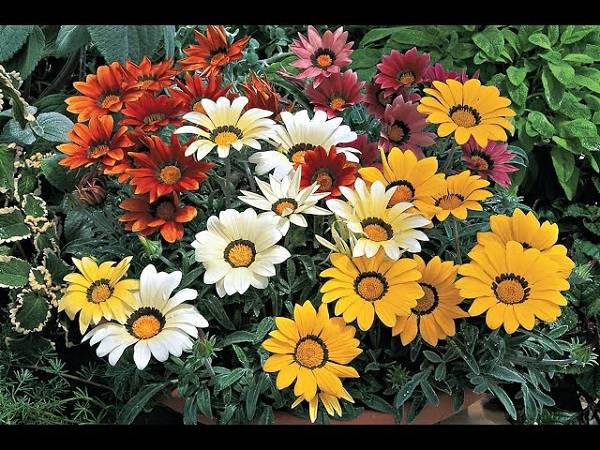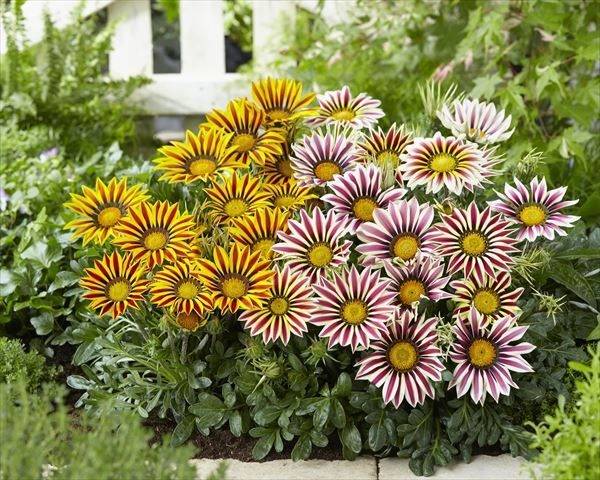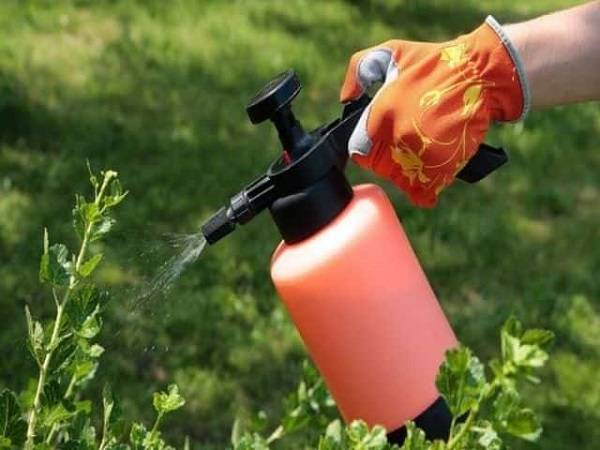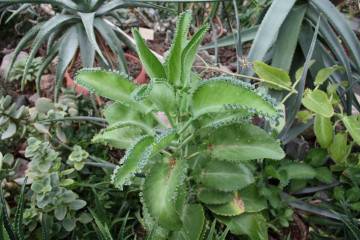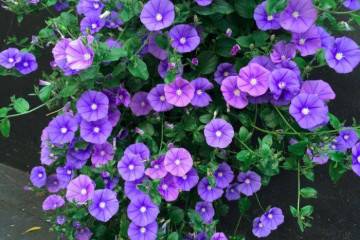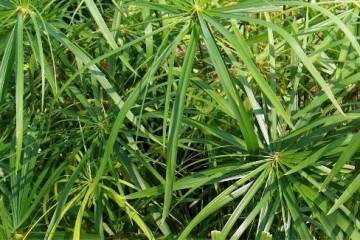Gatsaniya flower - how it blooms in a flower bed, what kind of soil is needed for growing
Content:
Gazania has another name - "African chamomile". Comes from the Astrov family. Outwardly, it really looks like a familiar chamomile, but it has a wide variety of petal colors.
Origin and appearance of gatsania
To date, approximately 40 types of gazania are officially known that exist in natural conditions. This "exotic beauty" came from southern Africa. It got its name in honor of Theodore of Gaza, a priest who lived in Italy in the 15th century.
In Europe, this plant is also called “nomad from Mozambique”.
Gazania and gatsania: how are they different
The flower is called differently: gazania and gatsaniya. The question arises: which name is correct? It turns out - both. You can call it whatever you like.
The Europeans gave the name to the flower Mittagsgold, which means "midday gold". It was so named because the petals open in the midst of noon.
Plant flower description
The gatsania flower is an annual or perennial of short stature. The stem is either short or completely absent. The rosette is formed by green or gray-green leaves tightly pressed against each other. The shape of the leaves is very diverse. You can find feathery and elongated leaves with silver-colored pubescence on the lower part.
Flowers up to 10 cm in diameter. The petals are elongated in the form of tongues. They have a different color depending on the variety. In nature, there are red, orange, white, bronze, white plants. During the season, an adult shrub forms up to 30 inflorescences.
The use of gazania in landscape design
The plant is very showy, therefore it is often used in landscape design in different variations. You can grow one variety or combine several varieties. The plant looks great in combination with other horticultural crops such as verbena.
Applications in garden decoration
African chamomile is bright and has a variety of leaf textures. This is the real dream of any landscape designer. Below are several options for decorating a garden with gazania:
- Framing borders. The small growth of the plant makes it useful as a decoration for paths and borders that divide the garden into several separate parts.
- Creation of flower beds. The combination of gats of different colors looks very good. The flowerbed looks luxurious.
- Creation of patterns by alternating with voluminous greenery. You can make "zigzags", "waves" and more complex patterns.
- When there are ugly areas in the garden with blackening soil, you can plant an African chamomile, which will hide this flaw.
Types of gazania
African chamomile varieties are divided into annuals and perennials.They differ in catchy, contrasting shades. There are also hybrid varieties.
Gazania perennial
Perennial gatsania is a compact shrub crop. The maximum height is 30 cm. There is practically no stem. It turns out that the leaves come out directly from the soil. It looks interesting and unusual. The foliage of a gray-green hue is very densely located. At the very bottom, the leaves are omitted. This is the reason for the retention of moisture near the base of the root system.
Winter is not terrible for perennials, because there are villi inside the plates. They serve as reliable protection of the flower from drought and hypothermia. A distinctive feature is the presence of specks at the base of the petals.
The flowering period is long - from July to the onset of the first frost. When the flowering period ends, fruit is formed. They are a box with villi, in which the seeds are located.
Gazania annual
Short shrubs obtained by crossing. The front side of the leaves has a rich dark green color, and the back is gray, with a touch of silver. Ideal for growing on loggias and balconies.
Gatsania harsh
Gatsania harsh is distinguished by a variety of shades of colors - bright yellow, orange, rich reds and even brown.
The peculiarity of this species is the quick opening of the bud at the beginning of the day and the quick closing at the onset of the evening.
Growing gatsania from seeds: when to plant seedlings
A common way of breeding gatsania is growing from seeds. The best time to plant seeds for seedlings is February-April. It is necessary to follow some rules for the seedlings to be strong and healthy.
Gatsaniya: sowing seeds for seedlings
At the bottom of the flower pot, drainage is first done with a thickness of at least 5 cm. Then soil is poured into the pot, consisting of peat and sand (1: 1). The seeds are sown and slightly pressed into the ground, which must be well moistened and covered with a film. The first shoots appear in 14-21 days.
Picking and hardening of seedlings
In the presence of 4 full-fledged green leaves, the seedlings must be dived. Plants are transplanted into ordinary plastic glasses filled with a substrate of peat and earth. Due to the long root, they are transplanted together with the soil in which the seedlings developed.
After the picking, the container must be placed in a room with an air temperature not higher than +15 degrees. For hardening, the seedlings are taken out to the balcony or any other open place with a temperature not higher than +10. For hardening, it is enough to leave the plants outdoors for a couple of hours.
When the air temperature reaches +20 degrees during the day, you can safely plant seedlings in open ground. As a rule, this is May-June. Seedling bushes are planted at a distance of 20 cm from each other. The plant will begin to bloom in about 2.5-3 months.
When planting a plant in open ground, the garden must be properly prepared:
- The soil must be nutritious, non-acidic. Depleted soil should be fed immediately.
- Planting is done with an old earthen clod to avoid trauma to the root system.
- A little peat and river sand must be added to the soil in the garden.
- Seedlings are planted only in a sunny place. Even the slightest shadow from other landings is unacceptable.
Gatsania: landing and leaving
Although the plant comes from warm places, caring for it does not take much time and effort.
What soil grows best
African chamomile needs nutritious soil to bloom. Adequate natural light is important. At the same time, the landing should be protected from drafts, strong gusts of wind. It is undesirable to plant gazania in areas with close groundwater.
Bloom
The first buds open in the middle of summer. Flowering continues until late autumn. Each inflorescence begins to fade only after 2-3 weeks. In cloudy weather, the buds remain closed.
What is the trick of a lush bloom? Just in compliance with the terms and rules of landing. And you also need to know how to feed gatsania for abundant flowering. African chamomile is very fond of feeding. Complex organic fertilizers are useful for her, as well as those that contain nitrogen. It is necessary to make top dressing before flowering.
Clayy, heavy soils are not suitable for gassing. The plant will not grow and develop well. Flowering in such soil should not be expected.
How to harvest gazania seeds
After the buds have faded, the seeds begin to ripen. The time to collect them comes when they start to fall to the ground. The seeds are collected and spread on a flat surface to dry for a couple of days.
Then they are placed in a paper bag and stored until next spring. Be sure to sign the name of the variety and the date when the seeds were collected.
How to prepare a plant for winter
If it is planned to preserve gazania flowers as a perennial, cultivation and care consists in the fact that the plant is taken from open ground for the winter and placed on the balcony (temperature + 9-11), after which it is brought into a warm room. Here the flower will spend the whole winter. During this period, it is worth limiting watering, but preventing the formation of a dry crust with cracks on the soil surface.
Features of growing gatsania as a perennial garden culture
African chamomile has its own characteristics in care. You need to know them in order to grow a beautiful bush covered with bright flowers. Difficulties can arise during the cultivation process.
What to do if gatsania does not bloom
Flowering may sometimes be absent. This is due to the fact that:
- the plant was planted at a later date;
- insufficient lighting;
- too frequent watering.
These are three main reasons why the long-awaited colors are not available.
What to do if the flower begins to fade
With the problem of wilting, you need to revise the irrigation schedule, and also exclude drafts.
The soil should always be sufficiently moistened, since a lack of moisture causes the plant to wilt and lose its decorative qualities.
Pests and diseases of African chamomile
Dangerous for exotic chamomile:
- spider mite;
- aphid;
- snails;
- gray rot of the root system.
To avoid snails, it is enough to remove weeds around the plant in time. Such drugs as "Fufanon", "Ditox" will help to get rid of other pests. Fitoverm, Biotlin, Aktara are good against aphids. But when a flower strikes gray rot, you just have to get rid of the diseased plants.
Gazania perennial or annual is an ornamental flowering plant native to warm regions. It has become widespread as a garden and indoor plant. With its help, they create stunning compositions in landscape design. At the same time, planting and caring for gazania does not take much time.
